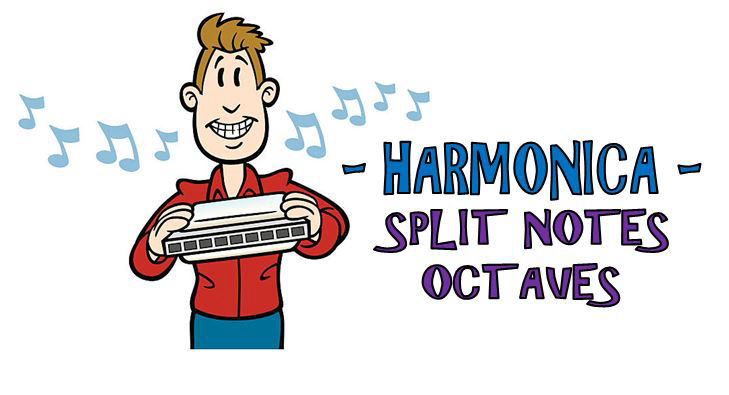In this lesson, we are going to practise playing split notes on harmonica, particularly octaves. What are octaves? An octave consists of two notes which are separated from one another by a distance of exactly 12 semitones.
Through this diatonic harmonica tutorial, I want to share with you a powerful exercise that will train you for playing octaves professionally and improve tongue position management during its execution. It’s obvious that we need to close intermediate holes in order to play split notes and therefore, to achieve this, we ought to make correct use of our tongue: i.e. incorporating tongue blocking technique.

Let’s take the keyboard of a piano as an example: if we press the C key with our right hand thumb while simultaneously pressing the next C with our little finger, we are actually initiating sequence of playing an octave.
The sound impression we get, when we play octaves, is more likely a full body sound as it confines within itself lower frequencies in combination with higher frequencies.
This attribute makes the tongue blocking technique even more intriguing; think of playing it in a way that allows to accomplishits complex level execution meanwhile yielding various articulations too.
Let’s explore which octaves we can possibly play on a diatonic harmonica:
The holes on the blow siden give rise to playing octaves of the notes C, E and G. All these octaves are three holes apart; e.g. the octave of C can be played by blowing holes 1 and 4 together at the same time. On a 10 hole diatonic harmonica, we can play three different octaves of C: i.e. on holes 1+ and 4+, 4+ and 7+, 7 and 10+

Similarly, the octaves of E can be played by blowing into holes 2 and 5 simultaneously or holes 5 and 8 at the same time. Note that we can only play two octaves of E.

The octaves of G are found on holes 3 and 6, or 6 and 9 blow – for this note also – we can play only two octaves on such type of instrument.

Things get a little more complicated when we talk about notes on the draw side:
If we look at the pictures on this page, we locate the octave of D on holes 1 and 4, or 4 and 8. In this case, the distance between the holes of the first octave is always three, whereas for the second octave, we have to widen the embouchure to produce sound on holes ,their distance being 4 positions apart. With the note D, we may execute only two octaves.

Then, there is an octave of A originating on holes 6 and 10 draw, with the distance still same; i.e. 4.

On the draw holes we can always play an octave of the note F, with distance of 4 holes. In this case, we have holes 5 and 9 to play.

Finally, the one we are left with, is an octave with B on the holes 3 and 7.

In this way we witnessed that there lies a certain difference between blowing octaves and that of drwawing them.
You’ll find the exercise,which I attached below, very useful in teaching you how to position your tongue precisely on the correct spot so as to begin playing octaves artistically.
First of all, we’ll play the high note then the octave, followed by the low note and after that coming back to the octave again. I would recommend performing this practice slowly so as to let your mind take its time to figure out exactly where to place the tongue at any time, and with what speed it needs to move from one hole to another to generate the right sound.
The first example I gave you involved the use of the soft pass between notes where as the other one utilized ‘staccato’ notes.
In the end one last note about this exercise: during its demonstration, I played holes 2 and 5 draw also, producing not an octave but a seventh chord shell, in particular the G7 one.
In fact, the notes played are G and F. During this step, it may happen that the sound of the hole 2 draw doesn’t come out as perfectly as expected. Don’t worry! This is quite normal, since we are playing the draw hole with an unusual embouchure in this case. Just keep you throat relaxed and inhale gently.
I hope to see you soon in the next lesson!